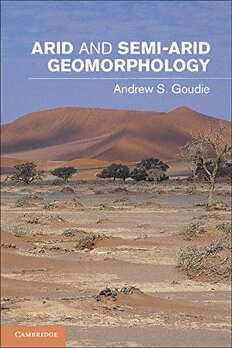Table Of Contentmore information - www.cambridge.org/9781107005549
ARID AND SEMI-ARID GEOMORPHOLOGY
Based on four decades of research by Professor Andrew S. Goudie, this volume
provides a state-of-the-art synthesis of our understanding of desert geomorphology.
It presents a truly international perspective, with examples from all over the world.
Extensivelyreferencedandillustrated,itcoverssuchtopicsastheimportanceofpast
climatic changes, the variability of different desert environments, rock breakdown,
wind erosion and dust storm generation, sand dunes, fluvial and slope forms and
processes,theroleoftheappliedgeomorphologistindesertdevelopmentandconser-
vationandtheEarthasananalogueforotherplanetarybodies.Thisbookisdestined
to become the classic volume on arid and semi-arid geomorphology for advanced
studentsandresearchersinphysicalgeography,geomorphology,Earthscience,sedi-
mentology,environmentalscienceandarchaeology.
andrew s. goudie isdirectoroftheChinaCentreattheUniversityofOxfordand
anhonoraryFellowofHertfordCollegeandStCrossCollege,UniversityofOxford.
Goudie was professor of geography and a Fellow of Hertford College from 1984 to
2003.Adistinguishedphysicalgeographer,heistherecipientofaRoyalMedalfrom
theRoyalGeographicalSocietyin1991,theDScfromOxfordin2002,thePrizeofthe
RoyalBelgianAcademyin2002,theGeologicalSocietyofAmerica’sFaroukEl-Baz
Prize for desert research in 2007 and the David Linton Award of the British Society
forGeomorphologyin2009.From2005to2009,hewaspresidentoftheInternational
Association of Geomorphologists and has also been president of the Geographical
Association, president of Section E of the British Association and chairman of the
British Geomorphological Research Group. He is also a former delegate of Oxford
University Press, former pro–vice chancellor and was Master of St Cross College,
Oxford(2003–2011).Hehasauthored,co-authoredoreditedmorethanthirtybooks
on physical geography, including The SAGE Handbook of Geomorphology (2011),
Landscapes and Geomorphology: A Very Short Introduction (2012), The Oxford
Companion to Global Change (2009), Encyclopedia of Geomorphology (2004) and
TheNatureoftheEnvironment(2001).
ARID AND SEMI-ARID
GEOMORPHOLOGY
ANDREW S. GOUDIE
UniversityofOxford
cambridge university press
Cambridge,NewYork,Melbourne,Madrid,CapeTown,
Singapore,Sa˜oPaulo,Delhi,MexicoCity
CambridgeUniversityPress
32AvenueoftheAmericas,NewYork,NY10013-2473,USA
www.cambridge.org
Informationonthistitle:www.cambridge.org/9781107005549
(cid:2)C AndrewS.Goudie2013
Thispublicationisincopyright.Subjecttostatutoryexception
andtotheprovisionsofrelevantcollectivelicensingagreements,
noreproductionofanypartmaytakeplacewithoutthewritten
permissionofCambridgeUniversityPress.
Firstpublished2013
PrintedintheUnitedStatesofAmerica
AcatalogrecordforthispublicationisavailablefromtheBritishLibrary.
LibraryofCongressCataloginginPublicationData
Goudie,Andrew.
Aridandsemi-aridgeomorphology/AndrewGoudie,UniversityofOxford.
pagescm
Includesbibliographicalreferencesandindex.
ISBN978-1-107-00554-9(hardback)
1.Geomorphology. 2.Deserts. 3.Aridregions. I.Title.
GB611.G674 2013
551.410915(cid:3)4–dc23 2012047937
ISBN978-1-107-00554-9Hardback
CambridgeUniversityPresshasnoresponsibilityforthepersistenceoraccuracyofURLsforexternalorthird-party
InternetWebsitesreferredtointhispublicationanddoesnotguaranteethatanycontentonsuchWebsitesis,orwill
remain,accurateorappropriate.
Contents
Preface pageix
Acknowledgements xi
1 Introduction 1
1.1 TheHistoryofIdeas 1
1.2 ClimaticConditions:Aridity 9
1.3 CausesofAridity 10
1.4 DesertRainfall 10
1.5 DesertTemperatures 14
1.6 TheAntiquityofDeserts 15
1.7 IncreasingAridity 17
1.8 QuaternaryFluctuations 17
1.9 LakesoftheQuaternary 22
1.10 TheGeographyandFrequencyofChange 28
1.11 SomeHoloceneEvents 30
1.12 Short-TermClimateFluctuations:ENSOandOtherPhenomena 31
1.13 VegetationCoverandAnimalActivity 33
1.14 TheImportanceofPlateTectonicSetting 34
1.15 TwoMainTypesofDesertTopography 35
1.16 TheHumanDimension 39
2 RockWeatheringandDesertSurfaces 42
2.1 RockWeatheringProcesses 42
2.2 Insolation,ThermalFatigueandDirtCracking 42
2.3 Fire 49
2.4 FrostWeathering 49
2.5 WettingandDryingWeathering 50
2.6 SaltWeathering 53
2.7 ChemicalWeathering 62
2.8 WeatheringbyBiologicalAgencies 63
v
vi Contents
2.9 SolutionProcessesandLimestone:Karst 64
2.10 Dayas 66
2.11 WeatheringForms 68
2.12 WeatheringPits 69
2.13 Tafoni 71
2.14 Alveoles 75
2.15 AmphitheatresandAlcoves 76
2.16 NaturalArches 77
2.17 PolygonalCracking(TessellationorAlligatorCracking) 78
2.18 Rock(Desert)VarnishandOtherRockCoatings 79
2.19 Duricrusts 82
2.20 Nitrates 83
2.21 GypsumEnrichment 86
2.22 Calcretes 90
2.23 Silcretes 94
2.24 Ferricretes 95
2.25 DesertTufasandStromatolites 95
2.26 SpringMounds 98
2.27 SurfaceTypes 99
2.28 Stone(Desert)Pavements 99
2.29 Takyrs 103
2.30 BiologicalCrusts 104
2.31 Inorganic(Rain-Beat)Crusts 105
2.32 Patterns 105
3 AeolianGeomorphology 114
3.1 Introduction 114
3.2 TheSpatialVariabilityofWindPower 114
3.3 PastWindVelocities 116
3.4 DustStorms 117
3.5 DesertLoess 131
3.6 Pans 139
3.7 Yardangs 146
3.8 InvertedRelief 150
3.9 RatesofDeflationandAbrasion 152
3.10 Ventifacts 153
3.11 CoastalSabkhas 153
3.12 SoilErosionbyWind 156
4 Dunes 160
4.1 Introduction 160
4.2 Ergs(SandSeas) 163
4.3 AnticyclonicSwirls,WhirlsandWhorls 165
4.4 Ripples 165
Contents vii
4.5 DuneTypes 166
4.6 MajorControlsontheNatureofDuneType 166
4.7 ObstacleDunes 170
4.8 Nebkhas 173
4.9 Lunettes 174
4.10 ReversingDunes 176
4.11 Barchans 176
4.12 TransverseRidges,ZibarsandDomeDunes 182
4.13 ParabolicDunes 183
4.14 LinearDunes 186
4.15 StarDunes 190
4.16 SpatialSuperimposition 192
4.17 SandSheetsandWindStreaks 193
4.18 SourcesofSand 193
4.19 AeolianiteandMiliolite 195
4.20 DuneColour 197
4.21 GrainShapeandSize 198
4.22 InternalStructuresofDunes 201
5 RiversandSlopes 204
5.1 FluvialProcessesandForms:Introduction 204
5.2 DrainageSystems 205
5.3 Pediments 207
5.4 AlluvialFans 213
5.5 DrainageDensity 217
5.6 BadlandsandGullyErosion 219
5.7 Arroyos 222
5.8 AridZoneFloodplains 224
5.9 Floodouts 227
5.10 GroundwaterSappingForms 228
5.11 LongProfiles 229
5.12 Processes:RunoffGeneration 230
5.13 Hydrophobicity 232
5.14 SedimentYieldandRatesofDenudation 232
5.15 RunoffandErosionintheNegevandJudeanDeserts 235
5.16 Sheetfloods 237
5.17 DebrisFlows 238
5.18 Palaeofloods 238
5.19 SomeSlopeForms:HillslopesinMassiveRocks 239
5.20 ScarpandCuestaForms 241
5.21 Long-TermRatesofOverallDenudationfrom
CosmogenicNuclides 244
viii Contents
6 AppliedGeomorphologyinDeserts:Hazards,ResourcesandtheFuture 246
6.1 Introduction 246
6.2 Hazards:DustStorms 248
6.3 DustControl 252
6.4 DuneMigrationandEncroachment 255
6.5 TheSaltWeatheringHazard 261
6.6 SlopeInstability 269
6.7 FluvialHazards 271
6.8 Subsidence 277
6.9 HydrocompactionandCollapsibleSoils 279
6.10 LakeShrinkageandExpansion 280
6.11 Piping 282
6.12 DamProblems 284
6.13 FutureClimates 286
6.14 GeomorphologyandArchaeology 292
6.15 DesertLandformsandWorldHeritage 294
6.16 DesertLandformsandMilitaryActivity 298
6.17 TheSearchforPlanetaryAnalogues 299
7 RegionalVariety 303
7.1 Introduction 303
7.2 Sahara 303
7.3 TheLibyanDesert 305
7.4 EasternAfrica 307
7.5 TheNamib 308
7.6 TheKalahariandtheKaroo 311
7.7 ArabiaandtheMiddleEast 313
7.8 TheThar 314
7.9 CentralAsia 315
7.10 Taklamakan,TarimandtheOtherChineseDeserts 316
7.11 HelmandandtheSeistanBasin 319
7.12 NorthAmericanDeserts 319
7.13 Atacama,Altiplano,Monte,PatagoniaandCaatinga 321
7.14 Australia 323
References 325
Index 449

